An Application of Decision Tree-Based Twin Support Vector Machines to Classify Dephosphorization in BOF Steelmaking
Abstract
1. Introduction
2. Theory and Methodology
2.1. Nature of the Data
2.2. Theoretical Model
2.3. Model Adequacy
3. Results
3.1. Descriptive Statistics
3.2. Model Hyper-Parameter Selection
3.3. Accuracy of Results
3.4. Justification for Twin SVM over Other SVM Models
4. Discussion and Interpretation of Results
4.1. Algorithm Performance
4.2. Application of the Results for Industry
5. Conclusions
Author Contributions
Funding
Conflicts of Interest
References
- Iron Ore Monthly Price-US Dollars per Dry Metric Ton. Available online: https://www.indexmundi.com/commodities/?commodity=iron-ore (accessed on 10 July 2019).
- Bloom, T. The Influence of Phosphorus on the Properties of Sheet Steel Products and Methods Used to Control Steel Phosphorus Level in Steel Product Manufacturing. Iron Steelmak. 1990, 17, 35–41. [Google Scholar]
- Chukwulebe, B.O.; Klimushkin, A.N.; Kuznetsov, G.V. The utilization of high-phosphorous hot metal in BOF steelmaking. Iron Steel Technol. 2006, 3, 45–53. [Google Scholar]
- Urban, D.I.W.; Weinberg, I.M.; Cappel, I.J. De-phosphorization strategies and Modeling in Oxygen Steelmaking. Iron Steel Technol. 2014, 134, 27–39. [Google Scholar]
- Balajiva, K.; Quarrell, A.; Vajragupta, P. A laboratory investigation of the phosphorus reaction in the basic steelmaking process. J. Iron Steel Inst. 1946, 153, 115. [Google Scholar]
- Turkdogan, E.; Pearson, J. Activities of constituents of iron and steelmaking slags. ISIJ 1953, 175, 398–401. [Google Scholar]
- Suito, H.; Inoue, R. Thermodynamic assessment of hot metal and steel dephosphorization with MnO-containing BOF slags. ISIJ Int. 1995, 35, 258–265. [Google Scholar] [CrossRef][Green Version]
- Healy, G. New look at phosphorus distribution. J. Iron Steel Inst. 1970, 208, 664–668. [Google Scholar]
- Turkdogan, E. Slag composition variations causing variations in steel dephosphorisation and desulphurisation in oxygen steelmaking. ISIJ Int. 2000, 40, 827–832. [Google Scholar] [CrossRef]
- Chattopadhyay, K.; Kumar, S. Application of thermodynamic analysis for developing strategies to improve BOF steelmaking process capability. In Proceedings of the AISTech 2013 Iron and Steel Technology Conference, Pittsburgh, PA, USA, 6–9 May 2013; pp. 809–819. [Google Scholar]
- Drain, P.B.; Monaghan, B.J.; Zhang, G.; Longbottom, R.J.; Chapman, M.W.; Chew, S.J. A review of phosphorus partition relations for use in basic oxygen steelmaking. Ironmak. Steelmak. 2017, 44, 721–731. [Google Scholar] [CrossRef]
- Kitamura, S.; Kenichiro, M.; Hiroyuki, S.; Nobuhiro, M.; Michitaka, M. Analysis of dephosphorization reaction using a simulation model of hot metal dephosphorization by multiphase slag. ISIJ Int. 2009, 49, 1333–1339. [Google Scholar] [CrossRef]
- Kitamura, S.; Kimihisa, I.; Farshid, P.; Masaki, M. Development of simulation model for hot metal dephosphorization process. Tetsu Hagane J. Iron Steel Inst. Jpn. 2014, 100, 491–499. [Google Scholar] [CrossRef]
- Chatterjee, S.; Hadi, A.S. Regression Analysis by Example; John Wiley & Sons: New York, NY, USA, 2015. [Google Scholar]
- Kloke, J.; McKean, J.W. Nonparametric Statistical Methods Using R; Chapman and Hall/CRC: Boca Raton, FL, USA, 2014. [Google Scholar]
- Wang, Z.; Xie, F.; Wang, B.; Liu, Q.; Lu, X.; Hu, L.; Cai, F. The control and prediction of end-point phosphorus content during BOF steelmaking process. Steel Res. Int. 2014, 85, 599–606. [Google Scholar] [CrossRef]
- He, F.; Zhang, L. Prediction model of end-point phosphorus content in BOF steelmaking process based on PCA and BP neural network. J. Process Control 2018, 66, 51–58. [Google Scholar] [CrossRef]
- Barui, S.; Mukherjee, S.; Srivastava, A.; Chattopadhyay, K. Understanding dephosphorization in basic oxygen furnaces (BOFs) using data driven modeling techniques. Metals 2019, 9, 955. [Google Scholar] [CrossRef]
- Wang, X.; Han, M.; Wang, J. Applying Input Variables Selection Technique on Input Weighted Support Vector Machine Modeling for BOF Endpoint Prediction. Eng. Appl. Artif. Intell. 2010, 23, 1012–1018. [Google Scholar] [CrossRef]
- Liu, C.; Tang, L.; Liu, J.; Tang, Z. A dynamic analytics method based on multistage modeling for a BOF steelmaking process. IEEE Trans. Autom. Sci. Eng. 2018, 16, 1097–1109. [Google Scholar] [CrossRef]
- Gao, C.; Shen, M.; Liu, X.; Wang, L.; Chen, M. End-point prediction of BOF steelmaking based on KNNWTSVR and LWOA. Trans. Indian Inst. Met. 2018, 72, 257–270. [Google Scholar] [CrossRef]
- Dou, Q.; Zhang, L. Decision tree twin support vector machine based on kernel clustering for multi-class classification. In Proceedings of the International Conference on Neural Information Processing, Siem Reap, Cambodia, 13–16 December 2018; pp. 293–303. [Google Scholar]
- Khemchandani, R.; Chandra, S. Twin support vector machines for pattern classification. IEEE Trans. Pattern Anal. Mach. Intell. 2007, 29, 905–910. [Google Scholar]
- Ding, S.; Yu, J.; Qi, B.; Huang, H. An overview on twin support vector machines. Artif. Intell. Rev. 2014, 42, 245–252. [Google Scholar] [CrossRef]
- James, G.; Witten, D.; Hastie, T.; Tibshirani, R. An Introduction to Statistical Learning; Springer Science + Business Media: New York, NY, USA, 2013. [Google Scholar]
- Friedman, J.; Hastie, T.; Tibshirani, R. The Elements of Statistical Learning; Springer Series in Statistics; Springer: New York, NY, USA, 2001. [Google Scholar]
- McLachlan, G.; Krishnan, T. The EM Algorithm and Extensions; John Wiley & Sons: New York, NY, USA, 2007. [Google Scholar]
- Carrasco, Oscar. Gaussian Mixture Models Explained. Available online: https://towardsdatascience.com/gaussian-mixture-models-explained-6986aaf5a95 (accessed on 1 August 2019).
- Comaniciu, D.; Meer, P. Mean Shift: A Robust Approach toward Feature Space Analysis. IEEE Trans. Pattern Anal. Mach. Intell. 2002, 24, 603–619. [Google Scholar] [CrossRef]
- Frey, B.J.; Dueck, D. Clustering by passing messages between data points. Science 2007, 315, 972–976. [Google Scholar] [CrossRef] [PubMed]

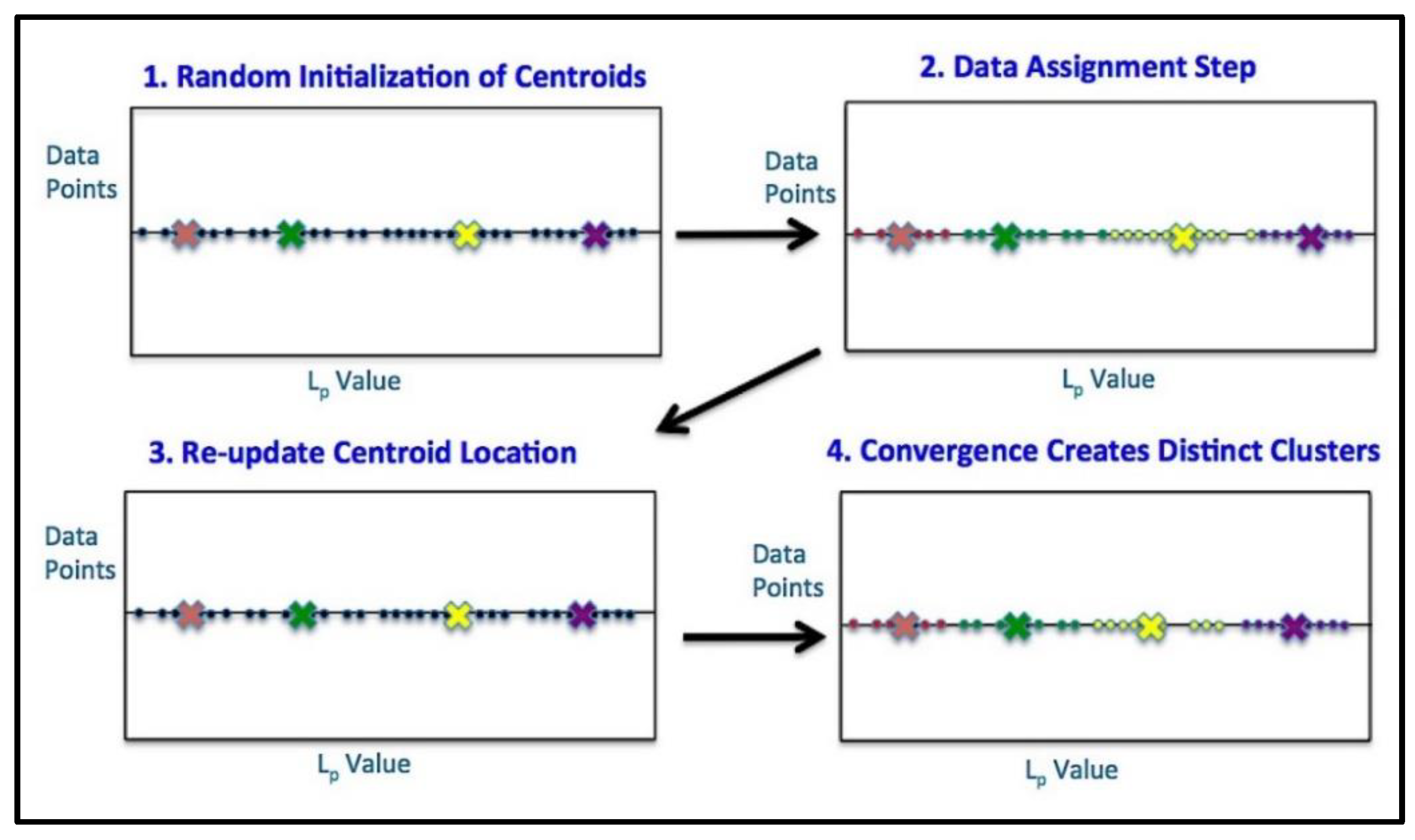
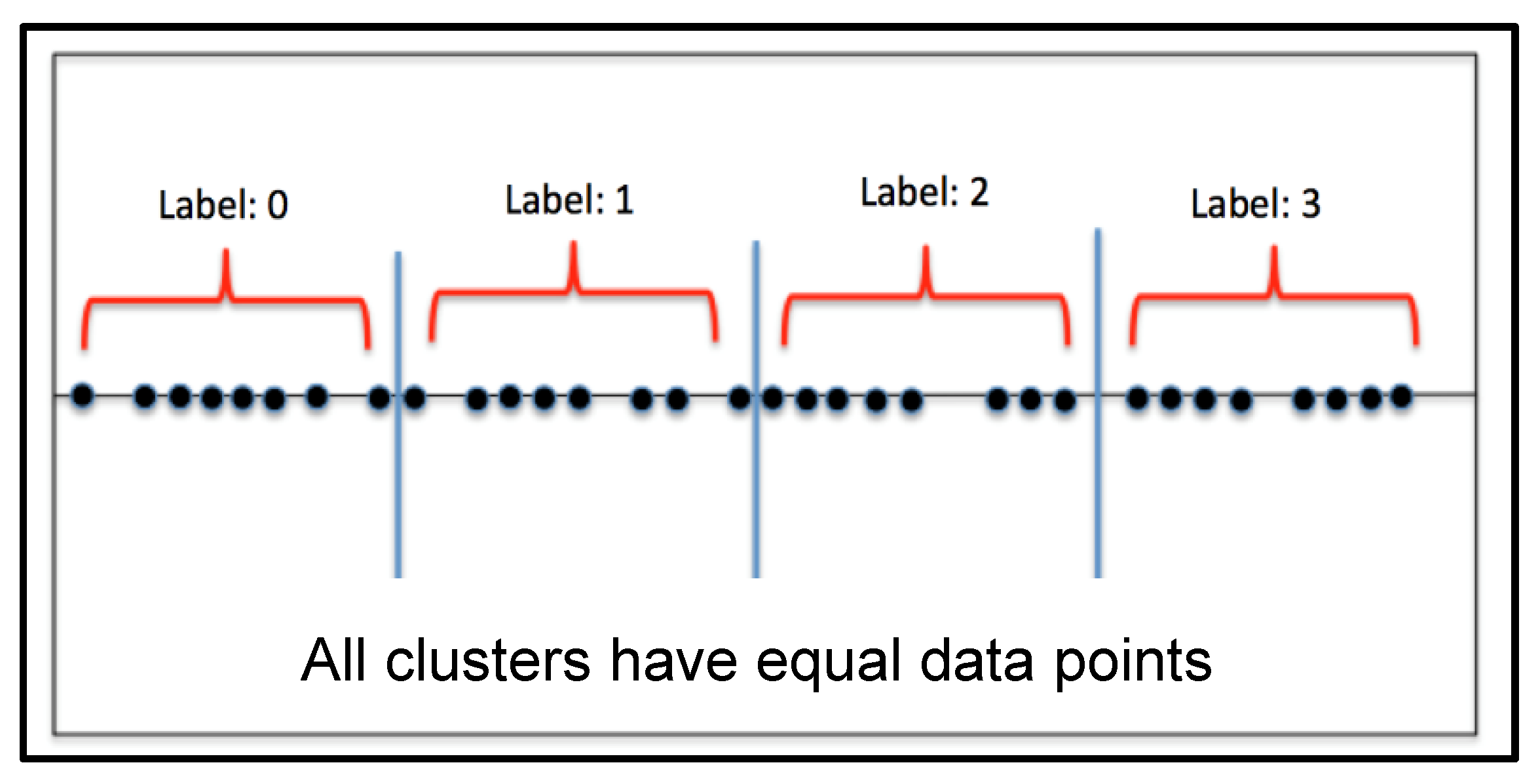
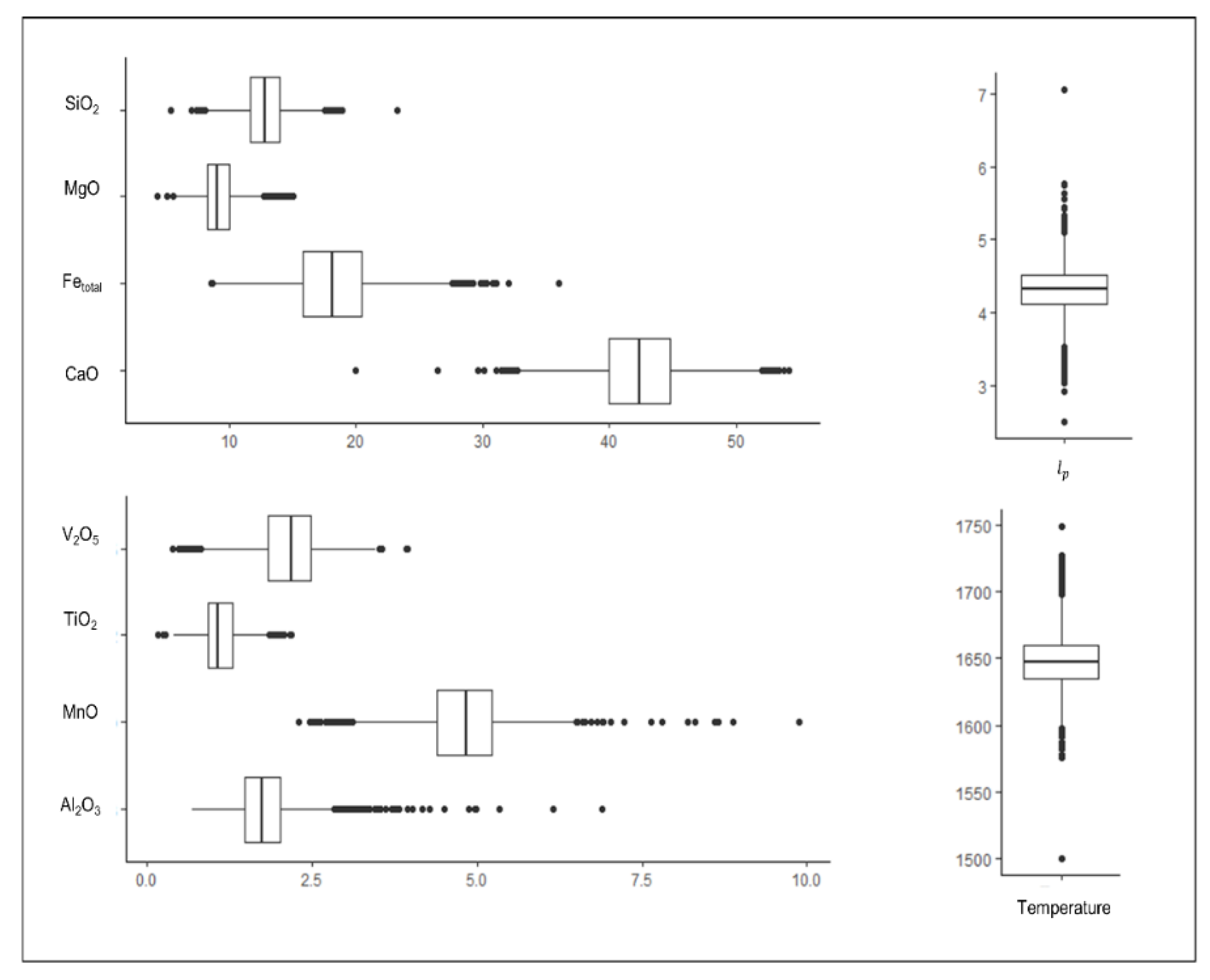

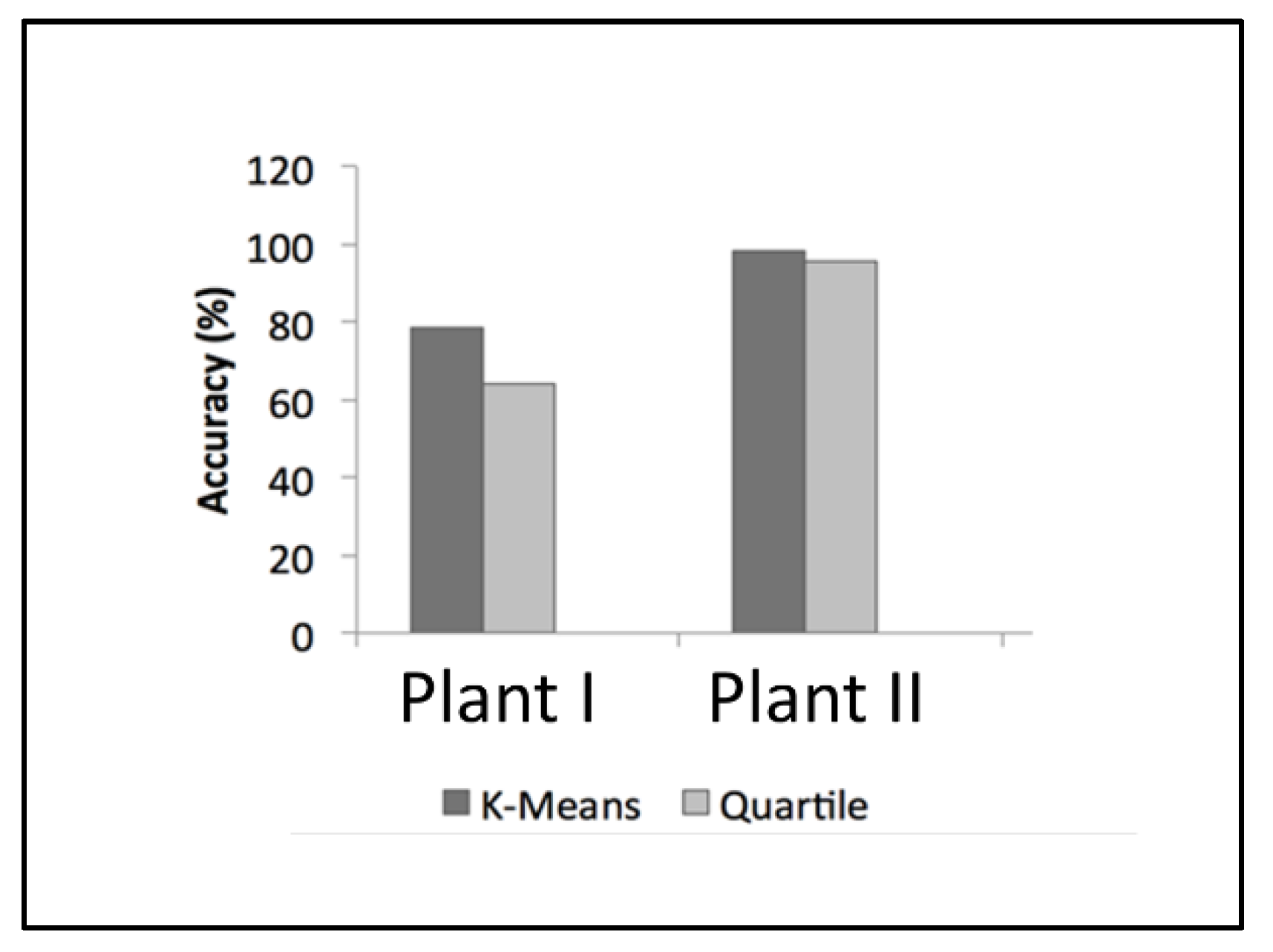
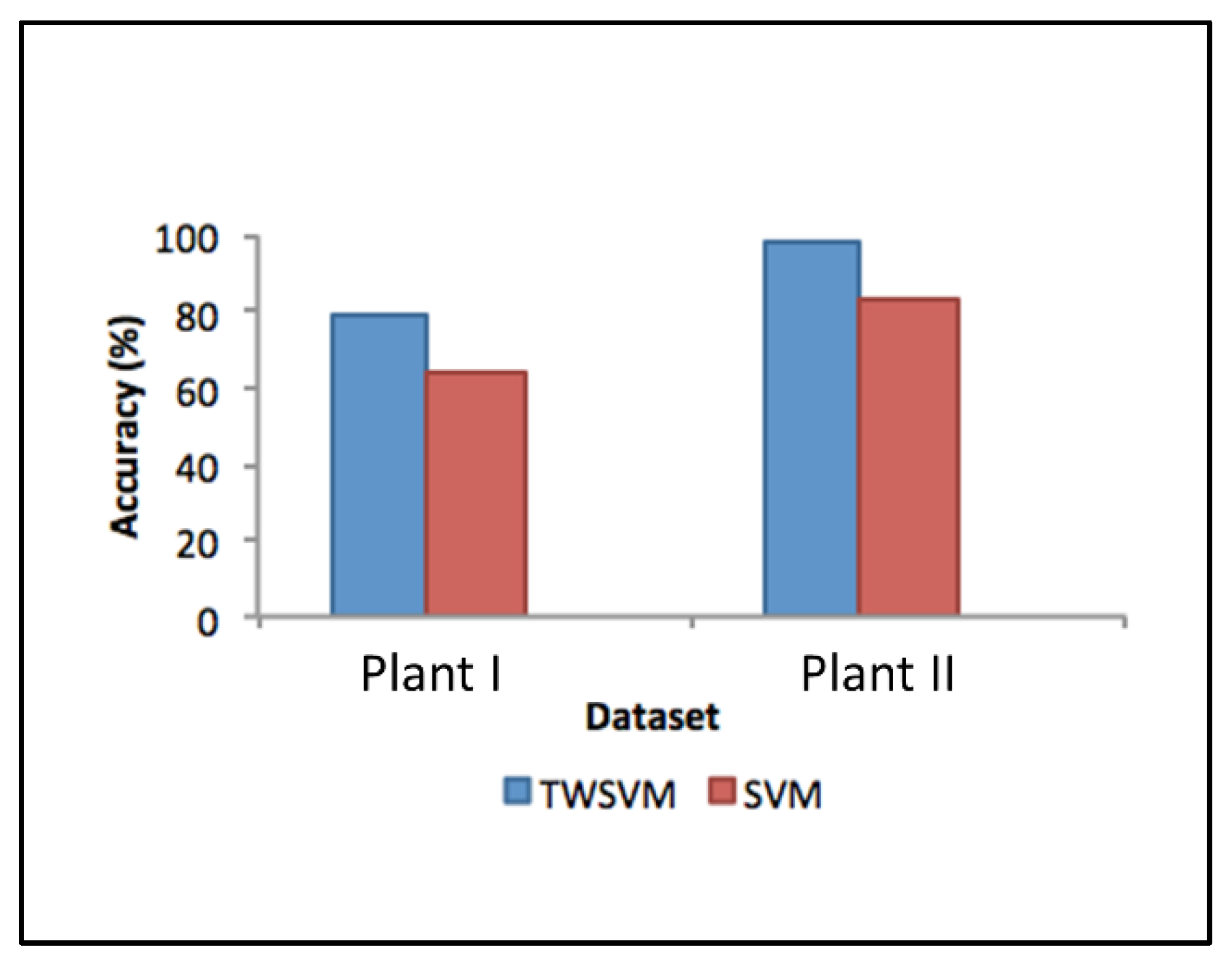
| Variable | Mean | Standard Deviation | Minimum | Maximum |
|---|---|---|---|---|
| Plant I | ||||
| lp | 4.31 | 0.30 | 2.50 | 7.06 |
| Temperature | 1648.82 | 19.14 | 1500.00 | 1749.00 |
| CaO | 42.43 | 3.62 | 20.00 | 55.90 |
| MgO | 9.23 | 1.37 | 3.75 | 16.46 |
| SiO2 | 12.89 | 1.74 | 5.40 | 23.30 |
| Fetotal | 18.22 | 3.53 | 7.70 | 36.00 |
| MnO | 4.80 | 0.70 | 2.28 | 11.98 |
| Al2O3 | 1.80 | 0.48 | 0.59 | 7.79 |
| TiO2 | 1.13 | 0.28 | 0.17 | 2.21 |
| V2O5 | 2.13 | 0.49 | 0.25 | 3.95 |
| Plant II | ||||
| lp | 4.63 | 0.34 | 2.77 | 5.64 |
| Temperature | 1679.10 | 27.11 | 1579.00 | 1777.00 |
| CaO | 53.45 | 2.30 | 42.33 | 64.06 |
| MgO | 0.99 | 0.34 | 0.30 | 3.18 |
| SiO2 | 13.52 | 1.44 | 8.16 | 18.74 |
| Fetotal | 19.34 | 2.06 | 13.71 | 29.72 |
| MnO | 0.62 | 0.18 | 0.24 | 2.50 |
| Al2O3 | 0.94 | 0.25 | 0.46 | 4.09 |
| Cluster Label | Frequency (%) | Mean | Standard Deviation | Minimum | Maximum |
|---|---|---|---|---|---|
| Plant I | |||||
| 0 | 2711 (19.57) | 3.76 | 0.16 | 2.50 | 3.94 |
| 1 | 5316 (38.37) | 4.12 | 0.09 | 3.94 | 4.26 |
| 2 | 4338 (31.31) | 4.41 | 0.08 | 4.26 | 4.56 |
| 3 | 1488 (10.75) | 4.72 | 0.14 | 4.56 | 7.06 |
| Plant II | |||||
| 0 | 1364 (44.23) | 3.66 | 0.56 | 2.77 | 3.99 |
| 1 | 1029 (33.37) | 4.30 | 0.13 | 3.99 | 4.49 |
| 2 | 584 (18.94) | 4.68 | 0.10 | 4.49 | 4.85 |
| 3 | 107 (3.46) | 4.99 | 0.11 | 4.85 | 5.64 |
| Hyperparameter | Starting Value | Increments | Ending Value | Selected Parameter (Plant I) | Selected Parameter (Plant II) |
|---|---|---|---|---|---|
| 0.1 | 0.1 | 2.0 | 0.4 | 0.5 | |
| 0.1 | 0.1 | 2.0 | 0.5 | 0.5 | |
| 0.1 | 0.1 | 2.5 | 1 | 1 | |
| 0.1 | 0.1 | 2.5 | 1 | 1 | |
| Kernel Type | Linear | N/A | Radial | Radial | Radial |
| Kernel Parameter | 0.5 | 0.1 | 3.0 | 2.5 | 2 |
| Labelling Method | GMM | Mean Shift | Affinity Propagation |
|---|---|---|---|
| Plant I Accuracy | |||
| K-Means | 78.76% | 71.77% | 72.00% |
| Quartile | 64.38% | 62.35% | 62.79% |
| Plant II Accuracy | |||
| K-Means | 98.03% | 98.01% | 96.58% |
| Quartile | 95.78% | 94.81% | 94.00% |
| Labelling Method | GMM | Mean Shift | Affinity Propagation |
|---|---|---|---|
| Plant I Accuracy | |||
| TWSVM | 78.76% | 71.77% | 72.00% |
| SVM | 72.97% | 74.79% | 76.11% |
| Plant II Accuracy | |||
| TWSVM | 98.03% | 98.01% | 96.58% |
| SVM | 97.45% | 98.00% | 96.42% |
© 2019 by the authors. Licensee MDPI, Basel, Switzerland. This article is an open access article distributed under the terms and conditions of the Creative Commons Attribution (CC BY) license (http://creativecommons.org/licenses/by/4.0/).
Share and Cite
Phull, J.; Egas, J.; Barui, S.; Mukherjee, S.; Chattopadhyay, K. An Application of Decision Tree-Based Twin Support Vector Machines to Classify Dephosphorization in BOF Steelmaking. Metals 2020, 10, 25. https://doi.org/10.3390/met10010025
Phull J, Egas J, Barui S, Mukherjee S, Chattopadhyay K. An Application of Decision Tree-Based Twin Support Vector Machines to Classify Dephosphorization in BOF Steelmaking. Metals. 2020; 10(1):25. https://doi.org/10.3390/met10010025
Chicago/Turabian StylePhull, Jovan, Juan Egas, Sandip Barui, Sankha Mukherjee, and Kinnor Chattopadhyay. 2020. "An Application of Decision Tree-Based Twin Support Vector Machines to Classify Dephosphorization in BOF Steelmaking" Metals 10, no. 1: 25. https://doi.org/10.3390/met10010025
APA StylePhull, J., Egas, J., Barui, S., Mukherjee, S., & Chattopadhyay, K. (2020). An Application of Decision Tree-Based Twin Support Vector Machines to Classify Dephosphorization in BOF Steelmaking. Metals, 10(1), 25. https://doi.org/10.3390/met10010025





